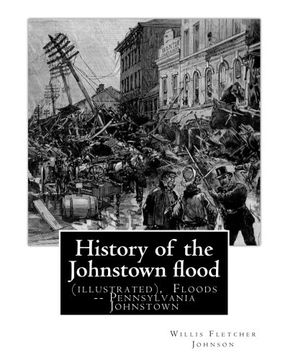Compartir
History of the Johnstown flood ... With full accounts also of the destruction on: the Susquehanna and Juniata rivers, and the Bald Eagle Creek. ... Johnstown. (Original Version)1889. (en Inglés)
Willis Fletcher Johnson
(Autor)
·
Createspace Independent Publishing Platform
· Tapa Blanda
History of the Johnstown flood ... With full accounts also of the destruction on: the Susquehanna and Juniata rivers, and the Bald Eagle Creek. ... Johnstown. (Original Version)1889. (en Inglés) - Johnson, Willis Fletcher
$ 23.57
$ 32.74
Ahorras: $ 9.17
Elige la lista en la que quieres agregar tu producto o crea una nueva lista
✓ Producto agregado correctamente a la lista de deseos.
Ir a Mis Listas
Origen: Estados Unidos
(Costos de importación incluídos en el precio)
Se enviará desde nuestra bodega entre el
Miércoles 17 de Julio y el
Miércoles 24 de Julio.
Lo recibirás en cualquier lugar de Internacional entre 1 y 3 días hábiles luego del envío.
Reseña del libro "History of the Johnstown flood ... With full accounts also of the destruction on: the Susquehanna and Juniata rivers, and the Bald Eagle Creek. ... Johnstown. (Original Version)1889. (en Inglés)"
Willis Fletcher Johnson (1857 - March 29, 1931), was an author, lecturer and for twenty years foreign and diplomatic editorial writer for The New York Tribune.The Johnstown Flood (locally, the Great Flood of 1889) occurred on May 31, 1889, after the catastrophic failure of the South Fork Dam on the Little Conemaugh River 14 miles (23 km) upstream of the town of Johnstown, Pennsylvania. The dam broke after several days of extremely heavy rainfall, unleashing 20 million tons of water (18 million cubic meters) from the reservoir known as Lake Conemaugh. With a volumetric flow rate that temporarily equalled that of the Mississippi River, the flood killed 2,209 people and caused US$17 million of damage (about $450 million in 2015 dollars).The American Red Cross, led by Clara Barton and with 50 volunteers, undertook a major disaster relief effort.Support for victims came from all over the United States and 18 foreign countries. After the flood, survivors suffered a series of legal defeats in their attempts to recover damages from the dam's owners. Public indignation at that failure prompted the development in American law changing a fault-based regime to strict liability.History The village of Johnstown was founded in 1800 by the Swiss immigrant Joseph Johns (anglicized from "Schantz") where the Stony Creek and Little Conemaugh rivers joined to form the Conemaugh River. It began to prosper with the building of the Pennsylvania Main Line Canal in 1836 and the construction in the 1850s of the Pennsylvania Railroad and the Cambria Iron Works. By 1889, Johnstown's industries had attracted numerous Welsh and German immigrants. With a population of 30,000, it was a growing industrial community known for the quality of its steel. The high, steep hills of the narrow Conemaugh Valley and the Allegheny Mountains range to the east kept development close to the riverfront areas. The valley had large amounts of runoff from rain and snowfall. The area surrounding Johnstown is prone to flooding due to its location on the rivers, whose upstream watersheds include an extensive drainage basin of the Allegheny plateau. Adding to these factors, slag from the iron furnaces of the steel mills was dumped along the river to create more land for building.[6] Developers' artificial narrowing of the riverbed to maximize early industries left the city even more flood-prone.The Conemaugh River immediately downstream of Johnstown is hemmed in by steep mountainsides for about 10 miles (16 km). Today, a plaque at the scenic overlook on Pennsylvania Route 56 about 4 miles (6 km) outside Johnstown cites this gorge as the deepest river gap in the United States east of the Rocky Mountains.

